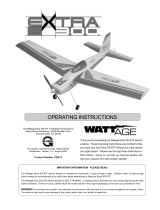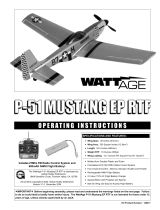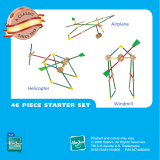
19
If you're flying the airplane and it seems to always want to turn right or left or pitch up or down, you can use the electronic
trim tabs on the transmitter to correct these tendencies. We suggest flying the airplane straight ahead and level, then let
go of the right-hand control stick for a few seconds. Watch what the airplane does. It may pitch up or down, or it may turn
right or left, or it may do a combination of these. Do this several times to double-check your findings. If the airplane does
one of the following while in straight and level flight without your hand on the control stick, move the following electronic trim
tab(s) to correct it:
●
If the airplane pitches up: Move the right-hand control stick vertical trim tab forward a couple of clicks.
●
If the airplane pitches down: Move the right-hand control stick vertical trim tab back a couple of clicks.
●
If the airplane turns right: Move the right-hand control stick horizontal trim tab left a couple of clicks.
●
If the airplane turns left: Move the right-hand control stick horizontal trim tab right a couple of clicks.
You can make these trim tab changes while you are flying, but we suggest having a friend move them for you so you don't
lose sight of the airplane. We also recommend moving the trim tabs only a couple of clicks at a time so you don't
over-correct for the trim problem.
SECTION 8: FLIGHT-TRIMMING THE SPORT-BIPE EP RTF
While you are learning to fly, there comes a time when you might crash. If the crash isn't too bad, most damage can be
repaired quickly and easily. If the damage is beyond repair, spare parts are available for purchase. If a foam part is going
to break during a crash it will usually break cleanly. To repair a clean break, follow the procedures below:
❑ Glue the broken parts together, using a thin layer of 5 minute epoxy or white glue, following the directions on the glue
bottle. Hold the parts together and in alignment until the glue fully cures.
❑ Apply a strip of clear Scotch
®
tape over the seams to strengthen the joint even more.
It is very important that you use no solvents or Cyanoacrylate (C/A) glue, which can damage foam. If any
of these chemicals comes in contact with the foam parts, the parts will be destroyed. Use only epoxy or white glue to
repair damaged foam parts.
SECTION 9: FIXING MINOR CRASH DAMAGE
SECTION 10: REPLACEMENT PARTS LIST
Wattage stocks a complete line of replacement parts for your Sport-Bipe EP RTF. Listed below are the replacement parts
that are available along with their respective part numbers for easy ordering convenience. We suggest ordering directly
from your local Wattage dealer. If your local dealer does not stock Wattage products, you can order directly from us at the
phone number or address shown on page # 2.
PRO TIP
Sport-Bipe EP RTF Complete ............................................ 128313
370 Motor w/Wire Lead & Pinion Gear .............................. 143050
Gear Box Assembly w/Shaft & Gears ................................ 143051
Propeller for Gear Box (2) .................................................. 143052
Propeller Nut (4) & Washer (2) .......................................... 143053
Rubber Spinner (2) ............................................................. 143054
2/3AA 600Mah NiMH Flight Battery ................................... 143055
Instruction Manual .............................................................. 143070
Top Wing ............................................................................. 143071
Bottom Wing ....................................................................... 143072
Outer & Middle Wing Strut Set w/Screws .......................... 143073
Fuselage w/Motor & Gear Box (No Electronics) ............... 143074
Molded Cowling .................................................................. 143075
Stabilizer Set ...................................................................... 143076
Main Gear Set .................................................................... 143077
Battery Door ....................................................................... 143078
Decal Set ............................................................................ 143079
Electronic Speed Control ................................................... 144048
Cirrus CS-09 Servo ............................................................ 444045
Cirrus CS-09 Servo Gear Set ............................................ 444948
Flight Battery Charger ........................................................ 144039
Receiver w/Crystal ............................................................. 443561
Crystal Set for Tx & Rx.......................................... 446004-446006



































